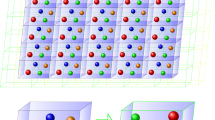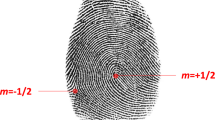Summary
The orientation of domains in transformed single crystals of KCN is considered in detail by means of stereographic projections. It is shown how the elements of point group symmetry of the high temperature phase divide on transformation into the intradomain symmetry elements that are preserved in the new crystal structure and the interdomain symmetry elements that relate individual domains possessing this new structure. A method of deriving the number of independent domain orientations is given in terms of these concepts and is applied to the alternative transformation schemes of KCN. Consideration is also given to the physical aspects of domain coexistence in KCN. The lattice changes which take place on transformation are considerable and it is shown that although « invariant » lattice planes common to two domain orientations do exist in some case, such a continuous transformation mechanism cannot account for all the domain orientations observed experimentally and an earlier conclusion that discontinuous processes must also occur is confirmed.
Riassunto
Le possibili orientazioni dei domini formati nella trasformazione di fase di un cristallo singolo di KCN vengono esaminate mediante proiezioni stereografiche. Si dimostra così che gli elementi di simmetria di gruppi di punti della fase stabile ad alta temperatura si dividono tra gli elementi di simmetria mantenuti nella nuova struttura cristallina e quindi esistenti all’interno di ciascun dominio, e gli elementi di simmetria che pongono in relazione tra loro i diversi domini. Viene dato un metodo per calcolare il numero delle orientazioni indipendenti dei domini, e tale metodo viene applicato nel caso dei due possibili schemi di trasformazione trovati per KCN. Vengono anche presi in esame alcuni aspetti fisici della coesistenza di differenti domini in KCN. Le variazioni reticolari che hanno luogo nella trasformazione sono notevoli. Si fa vedere che benchè esistano in alcuni casi piani reticolari invarianti, comuni a due orientazioni differenti, un simile meccanismo continuo di trasformazione non potrebbe rendere conto di tutte le orientazioni osservate sperimentalmente. Viene così confermato che debbono avere anche luogo processi discontinui.
Similar content being viewed by others
References
A. R. Ubbelohde:Quart. Rev.,11, 246 (1957).
A. Cimino, G. S. Parry andA. R. Ubbelohde:Proc. Roy. Soc., A252, 445 (1959).
J. M. Bijvoet andJ. A. Lely:Rec. Trav. Chim. Pays Bas,59, 908 (1940).
M. J. Burger:Elementary Crystallography (New York, 1956), p. 483.
See for instance the article byD. Turnbull, particularly Chapt. IV, 9, inSolid State Physics, Vol.3 (F. Seitz andD. Turnbull Editors) (New York, 1956).
M. A. Jaswon:Studies in Crystal Physics (London, 1959), p. 23.
Author information
Authors and Affiliations
Rights and permissions
About this article
Cite this article
Cimino, A., Parry, G.S. Interdomain symmetry in the reversible phase transformation of potassium cyanide. Nuovo Cim 19, 971–980 (1961). https://doi.org/10.1007/BF02731239
Received:
Published:
Issue Date:
DOI: https://doi.org/10.1007/BF02731239




